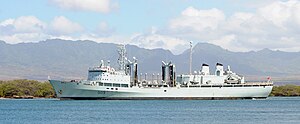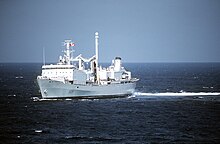
The Royal Canadian Navy is the naval force of Canada. The navy is one of three environmental commands within the Canadian Armed Forces. As of February 2024, the RCN operates 12 Halifax-class frigates, 12 Kingston-class coastal defence vessels, 4 Victoria-class submarines, 2 Harry DeWolf-class offshore patrol vessels, 8 Orca-class patrol vessels, and several auxiliary vessels. The RCN consists of 8,400 Regular Force and 4,100 Primary Reserve sailors, supported by 3,800 civilians. Vice-Admiral Angus Topshee is the commander of the Royal Canadian Navy and chief of the Naval Staff.

Iroquois-class destroyers, also known as Tribal class or DDG 280 class, were a class of four helicopter-carrying, guided missile destroyers of the Royal Canadian Navy. The ships were named to honour the First Nations of Canada.
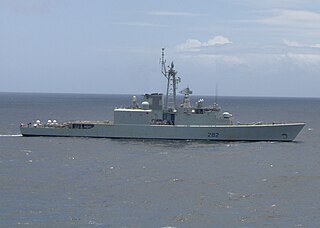
HMCS Athabaskan was an Iroquois-class destroyer that served in the Royal Canadian Navy from 1972 until 2017. Athabaskan was the third ship of her class which is sometimes referred to as the Tribal class or simply as the 280 class. She is the third vessel to use the designation HMCS Athabaskan.
The Protecteur-class auxiliary oiler replenishment (AOR) ships were used by the Royal Canadian Navy to resupply ships at sea with food, munitions, fuel and spare parts. They had more sophisticated medical and dental facilities than smaller warships. At 172 metres (564 ft) the ships were some of the largest operated by the RCN. Entering service in 1969, the last vessel of the class was paid off in 2016.

HMCS Chicoutimi is a Victoria-class long-range hunter-killer (SSK) submarine of the Royal Canadian Navy, originally built and operated by the Royal Navy as HMS Upholder. Shortly after being handed over by the United Kingdom to Canada she was involved in a partial flooding incident which resulted in a fire at sea. The incident sparked a fierce debate over the value of the purchase of this group of second-hand vessels, as well as the handover inspection process. The subsequent investigation "determined the fire was caused by human, technical and operational factors, [and] the board cleared the commanding officer and crew of any blame." The submarine was repaired and entered Canadian service in 2015.
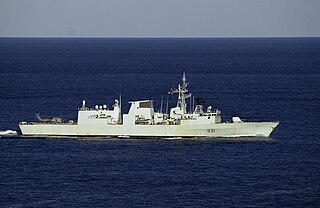
HMCS Vancouver is a Halifax-class frigate, of the Royal Canadian Navy launched on 8 July 1989, as the second vessel of her class. She is based at CFB Esquimalt on the west coast of Canada, and is the third vessel to be named after Vancouver, British Columbia.

HMCS Goose Bay is a Kingston-class coastal defence vessel that has served in the Canadian Forces since 1998. Goose Bay is the eighth ship of her class which is the name for the Maritime Coastal Defence Vessel Project. She is the first vessel to be named Goose Bay. The coastal defence vessel is assigned to Maritime Forces Atlantic (MARLANT) and is homeported at CFB Halifax.

HMCS Calgary is a Halifax-class frigate that has served in the Canadian Forces and Royal Canadian Navy since 1995. Calgary is the sixth vessel in her class and the second vessel to carry the designation HMCS Calgary. She was built as part of the Canadian Patrol Frigate Project. Calgary began the FELEX refit in June 2012. She is assigned to Maritime Forces Pacific (MARPAC) and is homeported at CFB Esquimalt. Calgary serves on MARPAC missions protecting Canada's sovereignty in the Pacific Ocean and enforcing Canadian laws in its territorial sea and exclusive economic zone.

HMCS Ottawa is a Royal Canadian Navy Halifax-class frigate. Ottawa is the twelfth and final ship of the Halifax class that were built as part of the Canadian Patrol Frigate Project. She is the fourth vessel to carry the name HMCS Ottawa. The first three were named for the Ottawa River. This ship is the first named for Canada's national capital, the City of Ottawa. She is assigned to Maritime Forces Pacific (MARPAC) and is homeported at HMC Dockyard, CFB Esquimalt. Ottawa serves on MARPAC missions protecting Canada's sovereignty in the Pacific Ocean and enforcing Canadian laws in its territorial sea and Exclusive Economic Zone. Ottawa has also been deployed on missions throughout the Pacific and to the Indian Ocean; specifically the Persian Gulf and Arabian Sea on anti-terrorism operations.

HMCS Regina is a Halifax-class frigate that has served in the Canadian Forces and Royal Canadian Navy since 1993. Regina is the fifth vessel in her class which is the name for the Canadian Patrol Frigate Project. She is the second vessel to carry the designation HMCS Regina. She is assigned to Maritime Forces Pacific (MARPAC) and is homeported at CFB Esquimalt.

HMCS Winnipeg is a Halifax-class frigate that has served in the Royal Canadian Navy since 1996. Winnipeg is the ninth ship in her class, whose design emerged from the Canadian Patrol Frigate Project. She is the second Canadian warship to carry the name HMCS Winnipeg. Winnipeg serves on Canadian Forces MARPAC missions protecting Canada's sovereignty in the Pacific Ocean and the Arctic Ocean and in enforcing Canadian laws on its territorial oceans and Exclusive Economic Zone. The vessel has been deployed on missions throughout the Pacific, and also to the Indian Ocean; specifically on anti-terrorism operations in the Persian Gulf and the Arabian Sea, and counter-piracy operations off the coast of Somalia. The ship is assigned to the Maritime Forces Pacific (MARPAC), and she has her home port at the Canadian Forces Maritime Base at Esquimalt.

HMCS Algonquin was an Iroquois-class destroyer that served in the Royal Canadian Navy (RCN) from 1973 to 2015.

HMCS Huron was an Iroquois-class destroyer that served with the Canadian Forces from 16 December 1972 to 23 October 2000. She served mainly on the western coast of Canada. After decommissioning, her hull was stripped to be used in a live-fire exercise. The ship's hulk was eventually sunk by gunfire from her sister ship, HMCS Algonquin. Huron was the second ship of her class and the second vessel to use the designation HMCS Huron.

HMCS Iroquois was the lead ship of the Iroquois-class destroyers of the Royal Canadian Navy, also known as the Tribal class or the 280 class. The second vessel to carry the name, she carried the hull number DDG 280. Entering service in 1972 she was assigned to Maritime Forces Atlantic (MARLANT) and was homeported at CFB Halifax. Iroquois was deployed overseas for blockade and anti-terrorism duties, including participating in Operation Apollo in 2002–03. Taken out of service in 2014 and paid off in 2015.
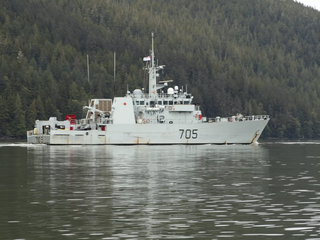
HMCS Whitehorse is a Kingston-class coastal defence vessel that has served in the Canadian Forces since 1998. Whitehorse is the sixth ship of her class. The first vessel named for the city in the Yukon, the ship is assigned to Maritime Forces Pacific (MARPAC) and is homeported at CFB Esquimalt.

HMCS Provider was a replenishment oiler and sole ship of her class of first the Royal Canadian Navy and later the Canadian Forces. She was the first dedicated auxiliary oiler replenishment ship commissioned for the Royal Canadian Navy in 1963, and the largest ship built in Canada to that date. Originally assigned to the East Coast, her open deck made her vulnerable and she was reassigned to the West coast. The ship was paid off in 1998, sold for scrap and broken up in Turkey in 2003.

USS Michael Murphy (DDG-112) is the 62nd ship of the Arleigh Burke class of guided missile destroyers in the United States Navy. She is named for Medal of Honor recipient Lieutenant Michael P. Murphy (1976–2005). Murphy was posthumously awarded the Medal of Honor for his actions during Operation Red Wings in Afghanistan in June 2005. He was the first sailor awarded the Medal of Honor since the Vietnam War. The ship's name was announced by Secretary of the Navy, Donald C. Winter on 7 May 2008. The ship was christened on 7 May 2011, Murphy's birthday, by her sponsor Maureen Murphy, Michael Murphy's mother. The ship is part of Destroyer Squadron 31 of Naval Surface Group Middle Pacific.
Operation Caribbe is the Canadian Armed Forces contribution to the elimination of illegal trafficking in the Caribbean Sea and the eastern Pacific Ocean by organized crime. The operation began in 2006 and its mandate has been altered twice since then. It operates as part of Operation Martillo.

MV Asterix is a Canadian commercial container ship. It was purchased by Federal Fleet Services as part of Project Resolve, and was later converted into a supply ship for the Royal Canadian Navy (RCN). She is intended to act as an interim replacement between the out of service Protecteur-class replenishment oiler and the future Protecteur-class auxiliary vessel. Originally launched in Germany in 2010 as Cynthia, the ship was converted and delivered to the RCN in December 2017 when she will be leased to the navy with a merchant navy crew, complemented by RCN personnel. Asterix will be in Canadian service well into the 2020s.

HMCS Harry DeWolf is the lead ship of its class of offshore patrol vessels for the Royal Canadian Navy (RCN). The class was derived from the Arctic Offshore Patrol Ship project as part of the National Shipbuilding Procurement Strategy and is primarily designed for the patrol and support of Canada's Arctic regions. Named after Vice Admiral Harry DeWolf, a former head of the RCN, the vessel was ordered in 2011, laid down in 2016 and launched in 2018. The vessel completed contractors sea trials in July 2020, was delivered to the RCN on 31 July 2020 and began post-acceptance sea trials. Harry DeWolf was commissioned on 26 June 2021.
